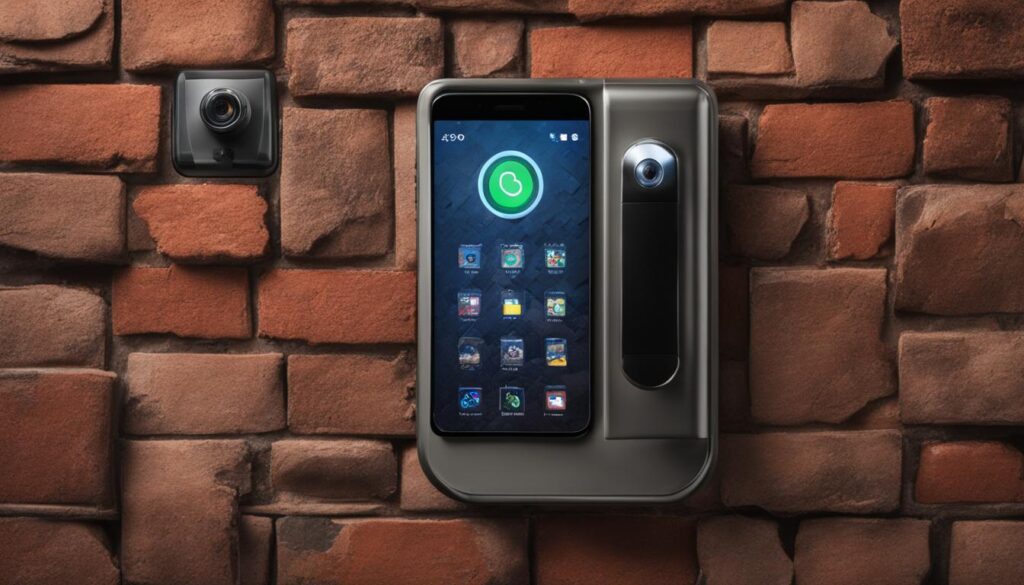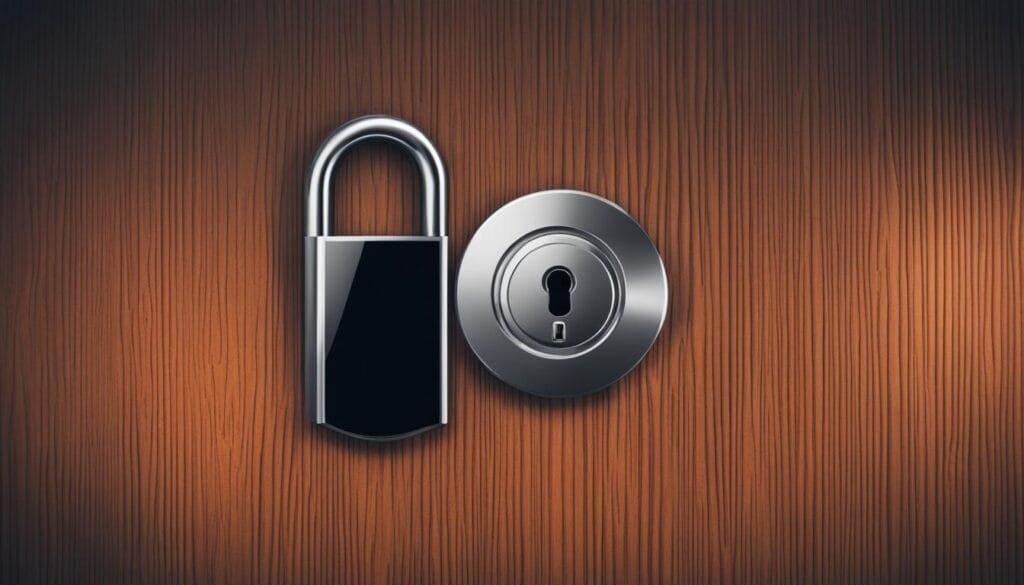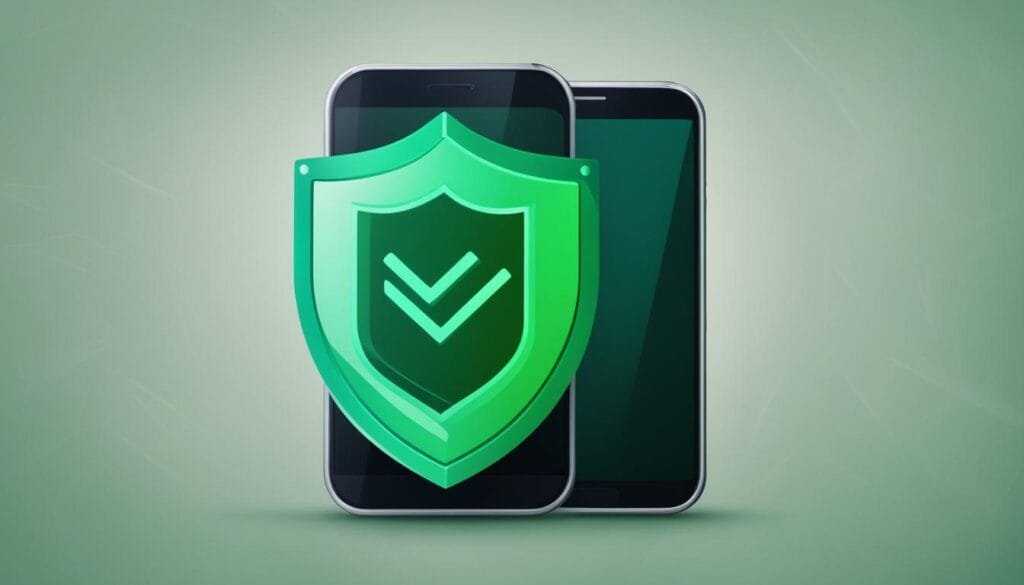Mobile banking has revolutionized the way we manage our finances, enabling us to make transactions on the go. However, with the convenience comes the risk of cyber threats and fraud. Ensuring the security of your mobile banking transactions is crucial to protect your hard-earned money. In this article, we will explore the best practices recommended by experts to help you bank securely on your mobile device.
Key Takeaways:
- Implement secure mobile banking practices to protect your finances.
- Download the mobile app from a secure source, such as your bank’s website.
- Banks use encryption technologies to safeguard your transactions.
- Beware of app-based banking Trojans and fake banking apps.
- Enable two-factor authentication and use strong, unique passwords.
The Safety of Mobile Banking
Mobile banking has become an integral part of our lives, allowing us to conveniently manage our finances on the go. However, concerns about the safety of mobile banking often arise. It is essential for users to understand that when proper precautions are taken, mobile banking can be a secure and reliable way to conduct transactions.
One of the key factors in ensuring the safety of mobile banking is downloading secure apps. When downloading a mobile banking app, it is crucial to do so from a reputable and trusted source, such as your bank’s official website. This guarantees that you are installing a legitimate and secure app. Banks invest in high-end encryption technologies, ensuring that their mobile apps are as secure as visiting a physical bank branch.
It is important to note that downloading apps from unofficial stores or third-party websites poses a significant risk. These sources may distribute malicious apps that can compromise the security of your mobile banking transactions. Protect yourself by sticking to trusted sources and avoiding unofficial app stores.
In summary, mobile banking is safe as long as you take the necessary precautions. Always download mobile banking apps from reputable sources, such as your bank’s official website. By doing so, you can enjoy the convenience of mobile banking while ensuring the security of your financial transactions.
Types of Cyberattacks to Watch Out For
Despite the safety measures in place, there are still potential cyber threats to be aware of when using mobile banking. Being aware of these types of attacks helps users stay vigilant and protect their personal information.
App-based Banking Trojans
One common type of cyberattack in mobile banking is app-based banking Trojans. These malicious programs are hidden within unrelated apps and can create pop-up overlays that mimic a bank’s login page. They trick users into entering their credentials, which are then captured by the attackers. It is important to always verify the legitimacy of the apps you download and be cautious when interacting with login prompts.
Fake Banking Apps
Another significant threat is fake banking apps. These apps impersonate legitimate mobile apps of banks and are designed to steal login credentials. They often appear legitimate, with similar branding and user interfaces, making it difficult for users to differentiate them from the genuine apps. To stay safe, it is crucial to only download banking apps from reputable sources, such as your bank’s official website or app store.
By being aware of app-based banking Trojans and fake banking apps, users can take necessary precautions when using mobile banking. It is always advisable to stay updated with the latest security information provided by your bank and to report any suspicious activities immediately.

| Cyberattack | Description |
|---|---|
| App-based Banking Trojans | Malicious programs hidden within unrelated apps that trick users into entering their login credentials on fake banking login pages. |
| Fake Banking Apps | Apps that impersonate legitimate mobile apps of banks and are designed to steal login credentials. |
Protecting Yourself Against Mobile Banking Fraud
When it comes to mobile banking, protecting yourself against fraud is of utmost importance. By following a few key practices, you can significantly reduce the risk of falling victim to cybercriminals. Here are some essential steps to take:
Download Verified Banking App
To ensure the authenticity and security of your mobile banking app, always download it directly from your bank’s official website. This guarantees that you are getting the legitimate and updated version of the app, free from any malicious software or tampering.
Enable Two-Factor Authentication
Two-factor authentication adds an extra layer of security to your mobile banking login process. By requiring an additional authentication step, such as a unique code sent to your mobile device, it becomes much more challenging for hackers to gain unauthorized access to your account. Make sure to enable this feature in your mobile banking settings.
Use Strong Passwords
When it comes to passwords, strong and unique combinations are essential. Avoid using common or easily guessable passwords. Instead, create a mix of upper and lowercase letters, numbers, and symbols. It’s also good practice to change your mobile banking password regularly and avoid reusing passwords across multiple platforms.
Avoid Public Wi-Fi Networks
Public Wi-Fi networks can be a breeding ground for cybercriminals. Avoid conducting financial transactions or accessing your mobile banking app while connected to public Wi-Fi networks. These networks are often unsecured, making it easier for hackers to intercept your data. Instead, use a secure and trusted network, such as your home Wi-Fi or mobile data connection.
By following these practices, you can enhance the security of your mobile banking experience and protect your personal and financial information from potential fraud. Stay vigilant and remain aware of the latest cybersecurity threats to ensure the safety of your mobile banking transactions.

How Banks Protect Customers from Cyber Threats
Financial institutions prioritize the security of their customers’ accounts and employ various measures to protect them from cyber threats. These measures include:
Monitoring Employees’ Behavior
Banks understand the importance of internal security and closely monitor their employees’ behavior to prevent any potential data breaches. Through robust security protocols, banks ensure that their staff adhere to strict guidelines and maintain the confidentiality of customer information.
Implementing Encryption Methods
One of the primary ways banks protect their customers is by using encryption methods to secure the transmission of sensitive information. Encryption transforms data into a coded format that can only be decoded by authorized parties, making it nearly impenetrable to cybercriminals.
“Encryption is an essential tool in safeguarding customer data. It ensures that even if intercepted, the information remains unreadable and useless to attackers.” – Cybersecurity Expert
Constantly Updating Security Systems
Banks stay proactive in the fight against cyber threats by regularly updating their security systems. By staying up to date with the latest security protocols and technologies, financial institutions can effectively mitigate risks and stay one step ahead of potential attackers.
By employing these security measures, banks maintain the safety and confidentiality of their customers’ financial data, providing them with peace of mind when conducting mobile banking transactions.

Conclusion
As our lives become increasingly digital, it is crucial to prioritize secure mobile banking practices to protect our finances. By following the best practices outlined in this article, such as downloading secure apps directly from trusted sources and using two-factor authentication, individuals can significantly reduce the risk of falling victim to mobile banking fraud. Implementing strong, unique passwords and avoiding public Wi-Fi networks while conducting financial transactions further enhances online banking safety.
Cybersecurity is a shared responsibility between users and financial institutions. Banks play a critical role in ensuring the security of their customers’ accounts by implementing robust security measures, such as monitoring employees’ behavior and utilizing encryption methods to protect the transmission of sensitive information. Constant updates to their security systems help mitigate risks and stay ahead of potential threats.
By working together, both users and financial institutions can create a safer mobile banking environment. Prioritizing cybersecurity and adopting secure mobile banking practices are essential to safeguarding our personal and financial information. As technology continues to advance, staying vigilant and informed about the latest threats and protection measures will help us navigate the digital landscape with confidence.
FAQ
Is mobile banking safe?
Yes, mobile banking is safe as long as certain precautions are taken. Downloading the mobile app from a secure store, such as your bank’s website, ensures a secure installation. Banks use high-end encryption technologies in their mobile apps, making them as safe as visiting a bank branch. It is important to only download apps from reputable sources and avoid unofficial stores.
What are the potential cyber threats in mobile banking?
Two common types of cyberattacks in mobile banking are app-based banking Trojans and fake banking apps. App-based banking Trojans are hidden within unrelated apps and can create pop-up overlays that mimic a bank’s login page, tricking users into entering their credentials. Fake banking apps impersonate legitimate mobile apps of banks and are designed to steal login credentials.
How can I protect myself against mobile banking fraud?
To protect yourself against mobile banking fraud, it is important to download the verified banking app directly from your bank’s website to ensure its authenticity. Enabling two-factor authentication adds an extra layer of security, and using strong, unique passwords that include a mix of upper and lowercase letters, numbers, and symbols is vital. Avoiding public Wi-Fi networks while conducting financial transactions and being aware of phishing and smishing attempts also help prevent unauthorized access to personal information.
How do banks protect customers from cyber threats?
Financial institutions invest heavily in protecting their customers from cyber threats. Banks implement various security measures, including monitoring employees’ behavior and looking for vulnerabilities in their apps that could be exploited by criminals. They use encryption methods to secure the transmission of information and constantly update their security systems to mitigate risks.
What are the Best Practices for Ensuring Security While Mobile Banking Abroad?
When engaging in mobile banking overseas, ensuring security in mobile banking overseas becomes crucial. It is advisable to use secure networks, avoid public Wi-Fi, and enable two-factor authentication. Additionally, installing a reliable mobile security app, keeping software updated, and regularly reviewing bank statements can safeguard your financial information while banking abroad.

